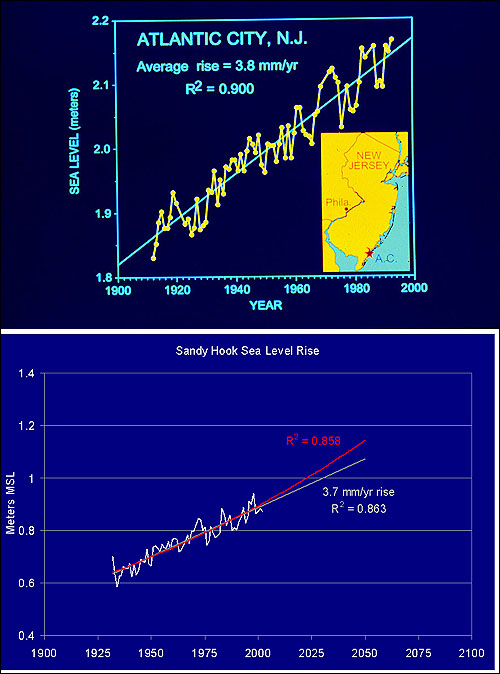| Index | ![[Next]](../../../images/next-red.gif) |
Introduction
One of the primary concerns of many coastal areas is how the community can respond, prepare, adapt, and prevent the negative effects of coastal hazards. These hazards include storms, persistent erosion, and sea level rise, among others. While storms produce significant change, it is the long-term effects of erosion and sea level rise that must be kept at the forefront of thinking for coastal decision maker's long-term plans.
Sea Level Rise
Sea level is rising for most of the coastal regions of the US. There are two types of sea level rise: eustatic (global average) and relative. Eustatic rise is a result of global warming (and a thermal increase in water resulting in a volume increase) and ice melting. This rise is approximately 2 mm/yr. Relative rise includes eustatic rise and the effects of compaction of sediments, tectonic changes including subsidence (sinking) or uplift, and loading. For New Jersey, sea level has a relative rise of approximately 4mm/yr.
 |
| Sea level rise at Sandy Hook and Atlantic City, New Jersey. Images: Jeffrey Pace, Rutgers University Coastal Geomorphology Group, Sandy Hook, NJ; and Mike Siegel, Rutgers Cartography, New Brunswick, NJ. |
While sea level rise itself acts slowly and poses little immediate threat, its main impact is to heighten the impact of erosion and accelerate the timetable for hazard planning.
Coastal Erosion
The majority of the New Jersey coast is eroding. This is due primarily to lack of suitable beach material being delivered to beaches by rivers or being transported from the nearshore. Additionally, much of the material that is delivered is captured in the nearly 43 kilometers of intermittently armored shoreline. This armoring includes seawalls, groins, jetties, rip-rap and bulkheads that can impede the natural movement of sediment along the shore.
 |
| The influence of coastal structures in New Jersey (Long Branch-left and Atlantic City-right)Images: Dr. N. P. Psuty, Rutgers |
Dune Maintenance
Dunes provide one of the primary source of protection for the coastal environment. While they are fragile, they provide both the mass and elevation necessary to protect infrastructure from storms. When a storm occurs the dune maybe be scarped (LISA PIC) but in most cases it will have protected the interior. However, dunes need beaches in front of them to be affective and be maintained.
Management Responses
There are two primary types of responses to net loss of sediment. These responses are termed hard stabilization and soft stabilization. Hard stabilization is primarily the building of structures to protect people's investments at the shore. These structures include the seawalls, groins, jetties, rip-rap and bulkheads mentioned and illustrated above. However, they are currently only used as a last result, and the past few decades have seen a shift to soft stabilization, namely sediment bypassing/recycling, and beach nourishment.
 |
| Sea Bright beach nourishment project conducted by the US Army Corps of Engineers, before nourishment (left) with nearly no beach, and after nourishment (right). Images: U.S. Army Corps of Engineers - New York District |
More Information
Search our toolkit for a collection of resources that will be valuable in learning more about techniques in dune and beach maintenance, management responses to erosion, and studies on sea level rise.
| Index | ![[Next]](../../../images/next-red.gif) |
